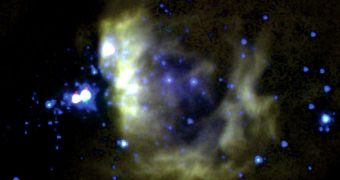Recently, a group of investigations identified a very interesting nebula in the sky, which they say contains an area that is in the process of giving birth to a new star. In other words, the massive clouds of cosmic dust and hydrogen gas that are generally credited for producing the celestial fireballs are currently in the process of collapsing in on themselves. The team behind the research is currently planning for a new round of observations, which they say will allow them a closer look inside the rare event. Witnessing the stellar formation process is extremely rare, and no one wants to miss this chance.
The star-forming cloud was identified in the direction of the southern constellation of Carina, in the southern sky. It was established to be located some 8,000 light-years away, and scientists say that they found it using the Australia Telescope National Facility’s (ATNF) 22-meter Mopra radio telescope, in southeastern Australia. The survey looked at more than 300 similar clouds, and result analysis showed that this particular one presented most interest for science. Though experts have a fairly firm grasp on how average stars form, they are still in the dark about the processes that drive the formation of massive ones, which can grow to be 50 times more massive than the Sun.
“We understand some of it, but we really don’t have a clear picture of what’s important. This should help us learn a lot more about the process,” said about the second observations campaign Peter Barnes. The expert, who is based in the United States, at the University of Florida, was the leader of the international astronomy team that discovered the cloud. Speaking about the size of the cloud, the expert adds that “It is a few light-years across, and it has maybe 20,000 times the sun’s mass worth of gas and dust, and most of that is participating in the collapse.” Experts were attracted to the cloud from the get-go, after they determined that it was diminishing, which means that its matter is falling in on itself.
In addition to the large Australian observatory, the team will also use the Chile-based Gemini South telescope to capture additional images of its target. The University of Florida-designed mid-infrared camera on Gemini is extremely suited for conducting such investigations, and that datasets obtained in this manner should complement those of the Mopra telescope beautifully. Details of the initial study were published in the latest issue of the monthly journal Notices of the Royal Astronomical Society, Space Fellowship reports.

 14 DAY TRIAL //
14 DAY TRIAL //